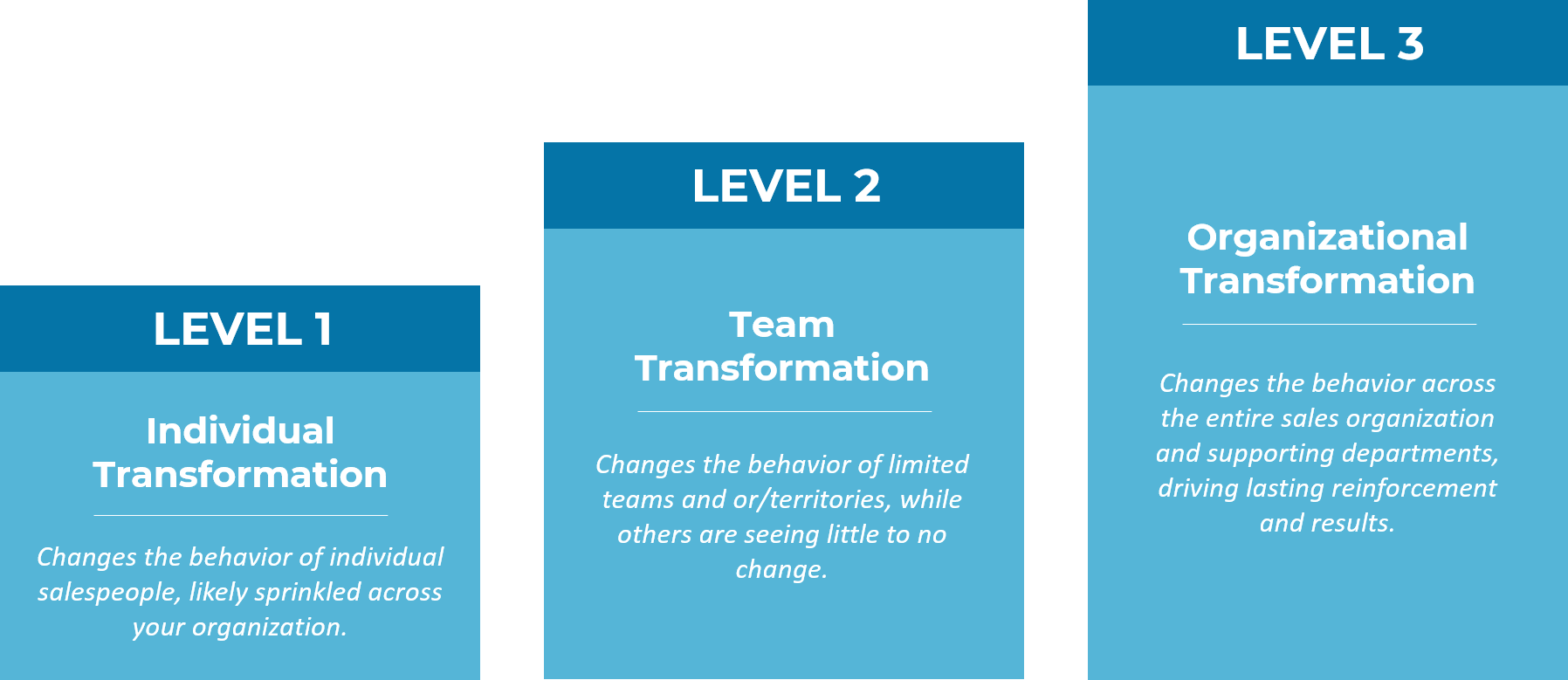
Sales Transformation: The Key to Organizational Success and Growth
Categories: Sales Transformation
Changing the sales behaviors of an entire organization requires time, commitment and a plan for reinforcement that drives lasting results. When done right, a well-thought-out strategic initiative creates organizational transformation in a way that accelerates growth and powers valuable exits for growing companies. Successful transformation is an outcome of a concerted effort to reinforce behavior change within the sales organization.
In our nearly 20-year history, we’ve worked with thousands of sales leaders, coaching them on how to drive lasting change that begins with the right sales capabilities. This experience has shown us that success can take a variety of forms, depending on how you operationalize and reinforce your efforts. The varying degrees of effort results in three levels of transformation:
1. Individual Transformation
Individual transformation happens when there is minimal alignment across teams and functions. Perhaps the opportunities are there for continual reinforcement, but few people and/or teams are taking advantage of them. Only the individuals who took the large-scale training event seriously are the ones who are now reaping the benefits of implementing the new sales methodologies that their organization has chosen to adopt.
These individuals developed their own understanding of the value of changing their behaviors and are now actually doing the work that changes outcomes. For this reason, success happens at the individual level. The transformation initiative changes the behavior in a limited number of salespeople across your organization, enabling these individuals with sales skills and capabilities that improve performance.
Evidence of Success: As a leadership team, you see success through individual benchmarks. Depending on the size of your organization, those exceeded quotas and record-setting deals can bring overall revenue success. You have some salespeople who are providing momentum in the organization, but it also means there are still gaps that need to be filled for your company to grow and scale.
2. Team Transformation
Team or territory transformation happens when a sales initiative or SKO type event creates results from more than just a few individuals. With this outcome, you have changed behavior from whole teams and/or territories. A few divisions have improved sales performance, but other territories are still dealing with the same setbacks that hindered numbers before the initiative. Territories that are showing improvements have managers and salespeople working together to reinforce behaviors, coach on new skills and validate successes. But, these territories are operating in silos. Some teams are showing consistent growth and improvement, but this success isn’t widespread.
Evidence of Success: Leaders see success through siloed pockets of growth. The return-on-investment from the initiative may even be there, thanks to these successful teams, but as a leader you don’t see broad success across your organization. If you’re implementing a phased approach to improving or evolving the sales strategy, siloed results and challenges will only amplify. Your executive team will now have to decide between moving forward with decreasing rates of success or backtracking to bring the entire organization up to speed and prepared to move to the next phase.
3. Organizational Transformation
Organizational transformation happens when sales organizations successfully build the right capabilities within their sales teams, foster cross-functional alignment around the buyer and build a continual reinforcement process embraced by the entire company. With this outcome, you have changed behaviors across your entire sales organization and supporting departments.
Company leaders and managers are actively leveraging a "lead from the front'' mentality, holding their people accountable for consistent execution and adoption of the change initiative. Other departments that interact with sales and buyers, (e.g., product, marketing, customer success, etc.) are aligned behind the initiative, as the initiative is integrated with company-wide goals and strategies. Reinforcement of changed sales behaviors happens beyond the sales organization, helping to bring consistency in the new way of doing business. This cross-functional alignment and continual reinforcement comes from an understanding of the value of the behavior and process changes. The people within the company know why they are doing things differently and are committed to achieving the desired and expected result.
Evidence of success: KPIs for the sales initiative are met, or even exceeded. You see success beyond just the sales team. The company’s executive team sees additional value in making on-going improvements to the sales strategy. Plans to further invest in enabling a revenue-driving sales organization can be developed and implemented in a similar fashion to scale sales success and accelerate business value.
You can download our full guide on Sales Transformation Initiatives: Three Levels of Results. Share it with others on your leadership and sales enablement teams to support conversations around implementing new sales behaviors and processes. If you're gearing up to launch something new in your sales organization, these additional resources on launching successful sales initiatives may support your next steps.
How Sales Leaders Achieve Organizational Sales Transformation
No matter the level of transformation you have, the outcomes from all three options are positive. However, in order to build resilience within your sales organization, organizational transformation should be the goal. It’s the only way to ensure the new or evolved sales behaviors stick in a way that helps the company thrive and scale. Still, organizational transformation can’t happen without widespread behavior change. If the goal of your transformation is increased revenue and stability in the marketplace, it should involve building a resilient salesforce that has the capability to maintain momentum, adjust to the changing needs of a buyer and continually perform in an elite way.
Considering a required change to your sales teams’ skills and behaviors? Hear a discussion on how cross-functional alignment creates resilient sales teams. In this on-demand webinar, Force Management's John Kaplan and Dave Davies cover how to build a culture of buyer alignment in your organization and enable sales to execute on this alignment where it matters most — the bottom line. Watch the webinar.




